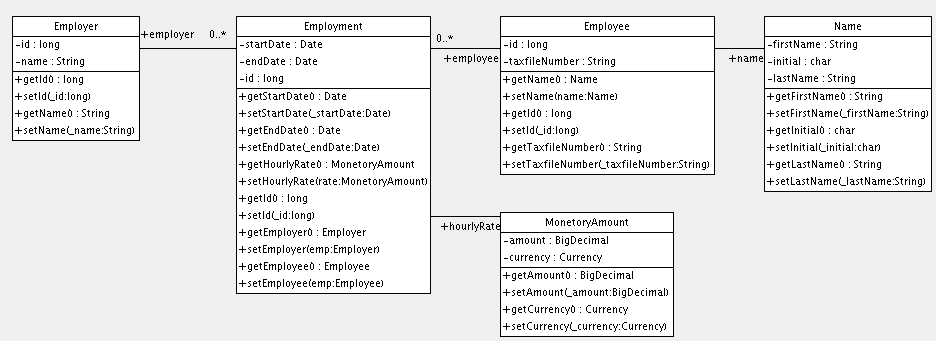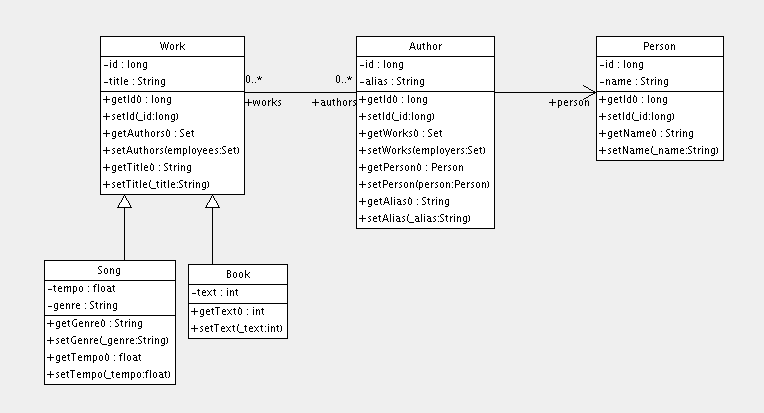本章将为你展示几个比较复杂的关联映射。
接下来关于Employer和Employee关系的模型使用了一个实体(entity)类(Employment)来表示这个关联,因为对于相同的雇主和雇员可能会有多个雇用时间段。对于雇用金额和雇员姓名,我们使用组件(component)来进行建模。

这是一个可行的映射文档:
<hibernate-mapping>
<class name="Employer" table="employers">
<id name="id">
<generator class="sequence">
<param name="sequence">employer_id_seq</param>
</generator>
</id>
<property name="name"/>
</class>
<class name="Employment" table="employment_periods">
<id name="id">
<generator class="sequence">
<param name="sequence">employment_id_seq</param>
</generator>
</id>
<property name="startDate" column="start_date"/>
<property name="endDate" column="end_date"/>
<component name="hourlyRate" class="MonetoryAmount">
<property name="amount">
<column name="hourly_rate" sql-type="NUMERIC(12, 2)"/>
</property>
<property name="currency" length="12"/>
</component>
<many-to-one name="employer" column="employer_id" not-null="true"/>
<many-to-one name="employee" column="employee_id" not-null="true"/>
</class>
<class name="Employee" table="employees">
<id name="id">
<generator class="sequence">
<param name="sequence">employee_id_seq</param>
</generator>
</id>
<property name="taxfileNumber"/>
<component name="name" class="Name">
<property name="firstName"/>
<property name="initial"/>
<property name="lastName"/>
</component>
</class>
</hibernate-mapping>这里是由SchemaExport生成的表结构。
create table employers (
id BIGINT not null,
name VARCHAR(255),
primary key (id)
)
create table employment_periods (
id BIGINT not null,
hourly_rate NUMERIC(12, 2),
currency VARCHAR(12),
employee_id BIGINT not null,
employer_id BIGINT not null,
end_date TIMESTAMP,
start_date TIMESTAMP,
primary key (id)
)
create table employees (
id BIGINT not null,
firstName VARCHAR(255),
initial CHAR(1),
lastName VARCHAR(255),
taxfileNumber VARCHAR(255),
primary key (id)
)
alter table employment_periods
add constraint employment_periodsFK0 foreign key (employer_id) references employers
alter table employment_periods
add constraint employment_periodsFK1 foreign key (employee_id) references employees
create sequence employee_id_seq
create sequence employment_id_seq
create sequence employer_id_seq下面的例子是关于Work、Author和Person。我们用多对多关系来表示Work和Author之间的关联,用一对一的关系来表示Author和Person之间的关联。另外一种可行的方式是对Author扩展Person。

接下来的映射文档正确地表示这些关系:
<hibernate-mapping>
<class name="Work" table="works" discriminator-value="W">
<id name="id" column="id">
<generator class="native"/>
</id>
<discriminator column="type" type="character"/>
<property name="title"/>
<set name="authors" table="author_work" lazy="true">
<key>
<column name="work_id" not-null="true"/>
</key>
<many-to-many class="Author">
<column name="author_id" not-null="true"/>
</many-to-many>
</set>
<subclass name="Book" discriminator-value="B">
<property name="text"/>
</subclass>
<subclass name="Song" discriminator-value="S">
<property name="tempo"/>
<property name="genre"/>
</subclass>
</class>
<class name="Author" table="authors">
<id name="id" column="id">
<!-- The Author must have the same identifier as the Person -->
<generator class="assigned"/>
</id>
<property name="alias"/>
<one-to-one name="person" constrained="true"/>
<set name="works" table="author_work" inverse="true" lazy="true">
<key column="author_id"/>
<many-to-many class="Work" column="work_id"/>
</set>
</class>
<class name="Person" table="persons">
<id name="id" column="id">
<generator class="native"/>
</id>
<property name="name"/>
</class>
</hibernate-mapping>在这个映射中有四个表。works,authors和persons分别存放著作、作者以及人的数据。author_work是关联表,把作者与著作关联起来。以下是由SchemaExport生成的表结构。
create table works (
id BIGINT not null generated by default as identity,
tempo FLOAT,
genre VARCHAR(255),
text INTEGER,
title VARCHAR(255),
type CHAR(1) not null,
primary key (id)
)
create table author_work (
author_id BIGINT not null,
work_id BIGINT not null,
primary key (work_id, author_id)
)
create table authors (
id BIGINT not null generated by default as identity,
alias VARCHAR(255),
primary key (id)
)
create table persons (
id BIGINT not null generated by default as identity,
name VARCHAR(255),
primary key (id)
)
alter table authors
add constraint authorsFK0 foreign key (id) references persons
alter table author_work
add constraint author_workFK0 foreign key (author_id) references authors
alter table author_work
add constraint author_workFK1 foreign key (work_id) references works接下来的例子是关于Customer、Order、LineItem和Product。Customer和Order之间是一对多的关联。那么Order/LineItem/Product之间的关联怎么表示呢?我们可以把LineItem作为关联表来表示Order和Product之间多对多关联,在Hibernate里,它被称为组合元素(composite element)。

映射文档:
<hibernate-mapping>
<class name="Customer" table="customers">
<id name="id">
<generator class="native"/>
</id>
<property name="name"/>
<set name="orders" inverse="true" lazy="true">
<key column="customer_id"/>
<one-to-many class="Order"/>
</set>
</class>
<class name="Order" table="orders">
<id name="id">
<generator class="native"/>
</id>
<property name="date"/>
<many-to-one name="customer" column="customer_id"/>
<list name="lineItems" table="line_items" lazy="true">
<key column="order_id"/>
<index column="line_number"/>
<composite-element class="LineItem">
<property name="quantity"/>
<many-to-one name="product" column="product_id"/>
</composite-element>
</list>
</class>
<class name="Product" table="products">
<id name="id">
<generator class="native"/>
</id>
<property name="serialNumber"/>
</class>
</hibernate-mapping>customers、orders、line_items和products分别存放客户、订单、订单项以及产品的数据。line_items作为关联表,把订单和产品关联起来。
create table customers (
id BIGINT not null generated by default as identity,
name VARCHAR(255),
primary key (id)
)
create table orders (
id BIGINT not null generated by default as identity,
customer_id BIGINT,
date TIMESTAMP,
primary key (id)
)
create table line_items (
line_number INTEGER not null,
order_id BIGINT not null,
product_id BIGINT,
quantity INTEGER,
primary key (order_id, line_number)
)
create table products (
id BIGINT not null generated by default as identity,
serialNumber VARCHAR(255),
primary key (id)
)
alter table orders
add constraint ordersFK0 foreign key (customer_id) references customers
alter table line_items
add constraint line_itemsFK0 foreign key (product_id) references products
alter table line_items
add constraint line_itemsFK1 foreign key (order_id) references orders